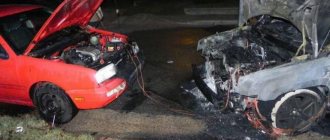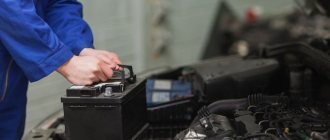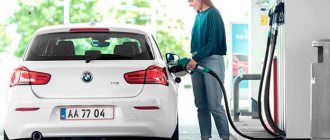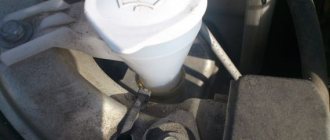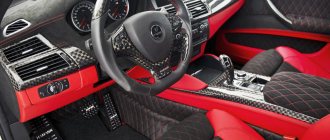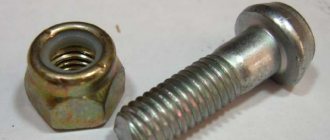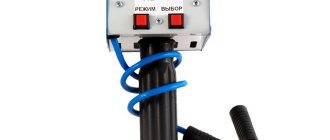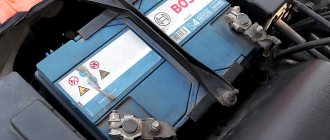A car owner needs to be prepared for any surprise. If the car does not start due to a dead battery, you will need help from an external power source. In professional slang, getting a charge from the battery of another car is called “lighting a cigarette.” To perform the operation, you need to know how to “light” the car correctly. What is needed to use the help of a donor, what tools are needed, what is the sequence of operations?
Is it harmful to “light” a car?
Having received a request for help to start the engine of another car, the question involuntarily arises: is it harmful to “light up”, to use your car as a donor. If your new battery is fully charged, the car is running, and you have some free time, it is unethical to refuse help. The batteries must be of similar capacity and voltage, the donor machine must be of the same or higher class.
“Lighting” another car from your car is harmful and dangerous if the operation is carried out like this:
- while “lighting” the car, the donor stands with the engine running;
- during the “lighting” process, the ignition on the car acceptor is turned on and electrical appliances are turned on;
- the donor is a smaller capacity battery;
- the sequence of operations when assembling and removing connecting wires is broken;
- small cross-section wires with poor-quality insulation, faulty contacts or “crocodiles” are used;
- safety measures are not followed.
If the operations are performed correctly, there will be no harm to the battery and on-board network of the other car. You cannot “light” an old battery. You should refuse the donor's service if his battery is leaking or there is an acidic smell.
Mistakes when “lighting up”: how not to carry out the procedure
When performing the “lighting up” procedure, you can make a number of mistakes that will lead to irreparable consequences. It is better to familiarize yourself with these errors immediately on the computer screen rather than during the startup procedure. Initially, it is suggested to watch a video that provides instructions on how to start the engine.
The differences between the described instructions and the one presented in the video are that a test run of the recipient car is performed while the engine of the donor vehicle is running. This option is unacceptable for the following reasons:
- The load on the generator increases, since it needs to produce a charge twice as large due to the voltage drop. This can lead to failure of the alternator on the donor vehicle.
- When starting the engine of the recipient car while simultaneously operating the donor motor, the circuit voltage will increase, so the fuses may blow, and in the worst case, the electronics may fail.
The instructions from the video are relevant for carburetor-type cars. Many motorists are accustomed to this method of starting, so they may wonder why they need to turn off the donor engine before starting the recipient engine. Even if you are accustomed to this method of “lighting up” on carburetor-type engines, it is recommended to use exactly the method described in the material. This will extend the life of the generator and also avoid melting fuses.
Let us highlight the main mistakes that motorists make when “lighting up” the engine:
- Carrying out the procedure with the donor engine running, as already mentioned above.
- The ignition on the donor vehicle or electrical appliances do not turn off.
- “Lighting” is carried out from a smaller capacity battery. Such a battery will never be able to start a more powerful engine than that installed on the donor.
- Failure to follow the sequence of actions, as well as violation of instructions.
- The use of low-quality wires, which can cause serious consequences.
- Failure to comply with safety regulations.
Moreover, mistakes are made not only by beginners in this business, but also by experienced drivers who have had to “light” their cars more than once. Safety precautions when “lighting up” a car states the following:
- The battery is an explosive device. To avoid an explosion, all actions must be performed strictly according to the instructions.
- Before “lighting”, you need to check the electrolyte level and whether it has frozen. To do this, unscrew the plugs in the cans, and then visually inspect the internal filling.
- There is evaporating hydrogen near the battery, so the presence of open flames, sparking and smoking are strictly contraindicated.
- Make sure the clamps are in good condition.
- Work with gloves and, if necessary, safety glasses.
Only after following all safety regulations can you begin work.
How to “light” a car correctly
A modern car has complex electronic components that require stable electrical parameters. Specialists and practitioners have developed an algorithm for how to safely “light” one car from another. The sequence of assembling the circuit and removing the wires when lighting a cigarette from the donor's car is important. During the charging period, a current of 300-400 A passes through the circuit; the created short circuit can cause a lot of trouble.
How to properly “light” your battery from another car? First of all, you need to get good quality connecting wires for lighting. Let them always be in the trunk. Included is a black wire for connecting to minus or ground, red for positive. The wires are massive, their cross-section is at least 16 squares. There are alligator clips on both ends. If you choose thinner cables, you may get burned by intense heat and even fire. In Chinese products, thin wires are often hidden under thick insulation.
When choosing a car for “lighting up”, make sure that it has a working battery of equal or greater capacity, but with the same output voltage. Before “lighting” your battery, check its serviceability. You cannot recharge if the battery is frozen in ice or leaking.
Before “lighting” a car from another car, you need to be sure that the car is fully operational, but the battery is dead. If the music is turned on in the cabin, the lights are on, the windshield wipers and lifts are working, but the engine is not a car. Why? The reason is not the battery.
Signs of a bad battery:
- when you turn the ignition key, straining sounds are heard;
- the indicators on the control panel do not light up or light up dimly;
- Uncharacteristic sounds are heard under the hood.
To “light” a car battery, you need to install it in an open place, with the possibility of access for another car. The car used as a donor must run at XX in order for its battery to be fully charged.
Watch a practical video lesson on how to “light” a battery.
Wire selection
To properly “light” a car from another car, you will need special wires with “crocodiles” at both ends. They can be bought at any auto store. The cost is around 1000 rubles. For example, the price for AIRLINE is 950 rubles. Try to buy wires of medium or long length, otherwise you may encounter inconvenience during work. Factory wires have insulation of different colors, usually black and red. The black wires are connected to the negative on one and the second battery, and the red wires are connected to the positive.
Instead of factory wires, it is quite possible to use any available wires with a suitable cross-sectional area. It should be at least 16 mm² (and preferably from 20 to 32 mm²). In this case, the stripped ends must first be tied with a loop of the same diameter as the battery terminals. And then just put them on.
When purchasing wires for “lighting”, you need to pay attention to the following nuances:
Wires for lighting
- Cross-sectional area . The larger it is, the more current can pass through it. If you buy a frankly cheap wire with a thin core, then there is a high probability of it burning out, especially when connecting to high-capacity batteries. The minimum cross-sectional area must be 16 mm² .
- Length . The short cable is inconvenient to use. Therefore, buy products at least 3 meters long .
- Insulation material . Don't buy hard braided wires. The fact is that in the cold it will harden and may crack. It is better to buy wires in soft PVC insulation. They bend better and do not crack at sub-zero temperatures.
- Alligator clips . It is desirable that they be copper, or at least have a copper-plated surface. This improves their conductivity. Also pay attention to their teeth. They must be sharp enough and tightened with a powerful spring to ensure good electrical contact. Choose crocodile models in which the wires are securely crimped, or better yet, soldered. This also contributes to good contact and reliability of the device.
Do not buy frankly cheap Chinese wires. They can only do harm. There have been cases when, during the “lighting” process, such wires overheated, their insulation melted or smoked. Not only is it impossible to start the engine with their help, but they also pose a potential danger. Therefore, we recommend that you do not save money, but buy high-quality wires for “lighting up”.
Instead of an afterword
We recommend that you buy and always carry with you wires for “lighting up”. They may come in handy in a critical situation. Also, always monitor your battery charge level, especially in winter. As for the actual process of starting the engine from another car, it is simple, and even a novice car enthusiast can do it. The main thing is to follow the necessary rules. And if necessary, give other drivers the opportunity to “smoke” your battery.
Source
How to “light” a car from another car using wires
So, you have selected a suitable car, placed it conveniently so that you can “light it” with wires. He has already worked, recharging the battery. How to correctly assemble a circuit for transfer from a donor?
- On both vehicles, turn off the ignition and all on-board electrical consumers.
- Assemble the circuit - connect the positive terminals of the batteries with a red wire. On the donor, we connect the black terminal to the battery terminal, the other end to the acceptor body, in a place where there is no paint, to ground.
- The donor engine starts and the battery is charged for 5-7 minutes. How much to “light” depends on the air temperature.
After recharging, the donor is completely turned off, the wires are removed and the recipient's car is test run. Result:
- the engine has started and runs smoothly;
- the start did not occur, the starter did not have enough energy to spin the engine;
- The starter works well, but the car will not start.
If there is not enough charge, you should “light” the car again for 10 minutes, according to the same scheme. If there is no result, you should call technical assistance. Reason: the fault is not in the battery.
The circuit is disassembled in reverse order. First, the ground wire is removed, then the positive terminals are released.
We suggest watching a video on how to “light” a car from another car.
How to remember the algorithm: a reminder for motorists
After reading the material or watching the video, it immediately becomes clear what the procedure is. However, once you find yourself in such a situation, everything is immediately forgotten. A person begins to panic, which often leads to rash actions. To start the engine, you need to rest and follow the “lighting up” procedure in accordance with the instructions.
If you forget the procedure, as well as the correct connection of the wires, then there is a hint in the form of an algorithm.
Reminder for motorists on “lighting up” a car
Briefly, the instructions consist of the following steps:
- Turn off the ignition on both vehicles, as well as related electrical appliances.
- Connect the wires observing polarity and sequence, as shown in the photo above.
- Run the donor engine for at least 5 minutes.
- Turn off the donor engine and turn off all related electrical appliances.
- Try to start the recipient's engine.
- After starting the engine, remove the wires in the reverse order of connection.
To carry out this procedure, it is not necessary to correctly understand the principle of operation. However, be sure to follow the sequence of actions in the instructions. If you understand the principle, then it will not be difficult for you to “light” the vehicle correctly and safely.
In conclusion, it is only possible to have a car whose battery is discharged, but is still in good working order. If the car has been sitting with a discharged battery for several weeks, then starting the engine by “lighting” is irrational. Such a battery will not be able to receive a charge, so in this case only buying a new battery will help.
- Author: Andrey
Rate this article:
- 5
- 4
- 3
- 2
- 1
(10 votes, average: 4.3 out of 5)
Share with your friends!
Home →
With your own hands →
How to “light” a car from another automatic car
Let's figure out whether it is possible to “light” a car with an automatic machine, or use another automatic machine as a donor? What is the difference? Electronic control systems are designed for constant voltage. If the battery has become completely unusable, after replacing it, the ECU will need to be reconfigured. Is it possible to recharge a dead battery locally from another car with an automatic transmission and how to give it a “light” to another car?
It is necessary to understand the principle of energy transfer. To “light” a car is to transfer the battery charge of one car to the battery of another, with a lower charge, via wires. The cars do not work, the ignition is turned off, the on-board systems are turned off. With a correctly assembled circuit, there is no danger of damage to the on-board system of the donor and acceptor.
When connecting wires that need to be used to “light” the car, it is necessary to observe the connection sequence and polarity. If the terminals are mixed up, a short circuit will occur with bad consequences.
“Light up” an automatic car correctly:
- Remove the key from the ignition and leave the door open. (When power is supplied, the machine will whine and the door lock will lock). Set both cars to the parking brake. The donor car must be warmed up by running the engine at idle for more than 5 minutes.
- First connect the positive wire, then the negative wire to the donor car.
- Perform the same operation on your Car, making sure that the poles are connected correctly.
- Get behind the wheel and start the engine. Set the engine to 1500 rpm and leave the engine running.
- Before removing the cigarette lighters, you need to turn on the resistance on your machine to smooth out the voltage surge. Do not turn on the lighting lamps - they may burn out. You can turn on the heated glass.
- Remove the wires first from the negative terminals, then from the positive.
This way you can “light” another car with a manual transmission from an automatic car.
There are posts on the Internet forum with information on how to “light” a working donor car. Is it possible to “light up” with a running car? If the donor battery operates with an open circuit, it does not power the on-board networks, and a voltage surge will not occur. When the engine is running, only the battery will be recharged, which resets the charge by “lighting” the dead battery. But by the time the driver makes a test run, the donor’s car must be turned off. Otherwise, a power surge may occur and expensive equipment may fail.
“lighting” a car is a simple process, but there are certain rules, we suggest watching the video.
What is needed for the procedure: how to choose wires?
The car from which it is planned to “light up” is called the donor, and the second one is called the recipient. To connect the donor to the recipient, you will need appropriate wires. Regular wires will not work, so do not try to start using them.
Why are special wires needed for “lighting”? During “lighting up” (when the engine of the second car starts), a large current consumption occurs. It exceeds the battery capacity by 5-7 times. If the wires have a small and insufficient cross-section, as well as if there are signs of damage, the consequences can be unpredictable. In order for motorists to imagine the danger of using incorrect, old and low-quality wires for “lighting up”, it is necessary to say about the possible consequences:
- inability to start the engine of a second car;
- melting of the insulation and electric shock if you hold onto the wire;
- sparking, ignition and failure of electronics and electronic devices.
Failure to follow instructions and safety rules when “lighting” a car can lead to dire consequences
This is interesting! It is contraindicated to use starting wires if even one of them has a faulty “crocodile” (lock or clamp) and the integrity of the insulation is damaged.
The situation with battery discharge is unpredictable, and it does not depend on what model of your car. Sooner or later you will need help starting the engine by “lighting up”. To carry out such actions, you need to purchase the appropriate wires. These wires are called “car starter wires” or “starter wires”.
Wires for starting the engine by “lighting”
These products consist of two wires, red and black. The ends of these wires have “crocodiles” for connection. The length of the wires affects the cost of the product, as well as voltage loss, but its minimum value is 1.5 meters.
This is interesting! You cannot “light” a gasoline car from a diesel engine, and vice versa. A diesel engine consumes more energy than a gasoline engine, so an attempt may result in failure at best, and in the worst case, failure of the electronics.
When choosing wires, it is important to consider the following criteria:
- Section . The main parameter, the value of which should not be less than 12-15 mm.
- Length of the product . The longer the wires, the easier it is to connect them to the donor. The optimal length is 2-3 meters.
- Loss of voltage . At 100 A, the loss value should not be more than 1.3 V, and at 200 A - no higher than 2.3 V every 1.5 meters of wire. The longer the wire, the higher the voltage loss, so it is not recommended to buy products whose length exceeds 4 meters.
- Wire cross-section material . High-quality wires are made only from copper, since this material has high conductivity. Aluminum wires will cost several times less, but they will be ineffective as they will have significant voltage losses.
- Places where the clamps (crocodiles) connect to the wires. These places must be securely crimped and also soldered. If the clamps with wires are one piece, then this is even better.
- Clamps. They must be made of copper and also have a reliable spring for high-quality clamping.
- Maximum current. This value should be at least 200A, since when starting the engine, a current of 5-7 times the battery capacity briefly flows through the wires.
Is it possible to make jumper wires for a car yourself? From a security point of view, this is not recommended. From an economical point of view, you can make the wires yourself, but subject to the following factors:
- for manufacturing, use thick wires, the cross-section of which should not be less than 10-12 mm;
- the wire material must be copper;
- there should be no places where the insulation is damaged;
- the length of the wires (each) should not be more than 2 meters;
- The wire should be connected to the clamp not only by crimping, but also by soldering using tin;
- perform reliable insulation of adhesion points.
Only after this can you use homemade wires to “light” the car. However, they should be used when the need arises, and not constantly, not forgetting that this is a homemade product.
Homemade wires for “lighting”: all conditions are met during production
How to properly “light” a car with a dead battery
There are so many cases when you need to “light up” a car, but the circumstances of the assistance and the sequence of some operations change. Much depends on the type of car - diesel or gasoline, automatic or manual. Experienced drivers have a well-established scheme for how to properly “light” their car from another, which donor is suitable and which is not.
So, the connection of the two batteries has been completed, we checked once again for correctness, so as not to get tangled in the wires, it is customary: red cables always connect the plus, the black cable goes from the minus of the donor to the ground of the recipient.
The most common way to properly “light” a dead car from another working one. You need to start the donor engine for the time necessary to recharge the dead battery. This can be from 5 to 20 minutes. Turn off a working car. Remove the wires and perform a test run. You may need to warm up the car a little more, or light up the car with a dead battery if the starter cranks lazily. As soon as the engine is started, the generator will begin to charge the battery, and after 10-15 minutes you can drive.
Another method is designed for experienced drivers with a conventional manual transmission and a minimum of electronics. The wires are connected. How to properly and quickly let the owner of a car with a new battery “light” it? Run the donor engine for 5-6 minutes. Try to start a faulty car. The startup attempt does not exceed 15 seconds, the interval is a minute. As soon as the engine starts, leave both cars turned on and tied to the donor for 3 minutes. Before disconnecting the wires from the terminals in the onboard line, turn on the resistance to smooth out the voltage surge.
“Lighting up” is an undesirable, emergency and dangerous operation. Is it possible to “light” a car if the donor driver has doubts about the serviceability of the battery? The owner's concerns are justified:
- when the frost outside is below -20 0;
- the class of the idle machine is higher;
- higher capacity battery;
- diesel engine.
How to properly “light” a car from another car, look at the video.
Starting the car
The rechargeable battery (ACB) is the source of power supply for an idle vehicle. It also serves to start the engine through the ignition system. If the battery is so discharged that it is unable to turn the starter a few times, there are two main ways to start the engine.
- Start the engine from the pusher. This is what drivers call a method when a car in distress is towed by another vehicle or manually pushed by several people. When accelerating on a faulty car, engage 2nd gear and release the clutch pedal. The ignition must be turned on.
- Lighting a cigarette from someone else's car battery. It is used constantly, especially in cases where the battery is completely discharged and does not even create a spark on the spark plugs, or the car is prohibited from starting by any type of towing (cars with an automatic transmission). The easiest way, of course, is to replace the battery with a new one, but on the road it is not always possible to buy a battery.
Lighting a cigarette from another battery means connecting an additional power source to the electrical ignition circuit using connecting wires. In this case, the discharged battery also remains in the lighting process circuit.
It is important to know how to correctly connect the wires and perform the steps to start the engine from an external source, so as not to cause any damage to either the emergency vehicle, the donor vehicle, or both batteries.
How to properly “light” a car from another battery
In our fast age, when “time is money” for every car owner, searching for a donor can take a lot of time. It is much easier to have your own external battery, which will help out in difficult times. Such devices include a starting booster, a car battery charger, and a backup battery. Then will it be possible to “light” from a battery without a car, but according to the same principle as taking energy from another car? Yes.
To “light” the battery, you will need a car booster. The device is pocket-sized, but has enough energy to cope with starting the engine when the battery is completely discharged. The device has 2 modes: it can “light” the battery, recharge it, or it can take over the energy supply instead of a completely discharged battery.
The booster can “light up” not only a car battery, it can also be used to charge electronic gadgets when the network is unavailable. But its cost is high. Basically, such portable compact chargers are used to “light up” a car in cases where the battery loses charge and capacity during long trips. Special starting chargers are compact and serve to “light” a car from another battery. Assembling the correct power supply circuit from an external source is relevant, this is the same as “lighting up” from an external battery.
The main problem with using external energy storage devices is their ability to make only a few starts. But there are professional boosters that work from the network. But in case of force majeure, “lighting” the car from an external battery is a salvation.
The correct “lighting up” process
Connection diagram for “lighting up”
Now let’s move on to considering the algorithm for how to properly “light” a car. The sequence of actions will be as follows:
- Before the procedure, the engine of the donor car should run for about 5 minutes at 2000. 3000 rpm. This is done so that the battery is additionally recharged.
- Before “lighting up,” the engines, ignition, and all electrical appliances of both cars must be turned off! This is a mandatory requirement, which we will talk about with you later.
- Connect the ends of the “positive” wire first to the battery of the donor car (from which they “light”), and then to the recipient car.
- Connect the ends of the negative battery cable. First, to the negative of the donor car battery , and then to any metal surface that has been cleaned of paintwork (for example, an engine block) or to a protrusion on the car body. However, remember that when starting the engine, there is a possibility of a spark occurring at negative, which can hit the accumulation of oil and dirt, which in turn can cause a fire and even an explosion. Therefore, observe fire safety and “light up” outdoors or in a well-ventilated area. If you do not find a suitable protrusion, then connect the wire to the negative of the recipient battery.
How to “light” a car correctly
If it was not possible to “light” the car within a few seconds, then you should not “torture” the battery. Try this:
- With the wires connected and the recipient engine and ignition off, start the donor engine.
- Let it run for about 10 minutes at 2000. 3000 rpm. This will recharge both batteries.
- Turn off the engine, ignition and all electrical appliances of the donor. Try again to start the recipient's engine.
Thus, it is not at all difficult to “light” a car correctly from another battery. Now let's look at some common myths and useful tips.
Beginning of “lighting up”
If you realize that your car’s battery is completely dead, and you have wires for “lighting” in the trunk, then you should look for the driver with the car and persuade him to help you. Not all drivers agree to help, but if you do find one, you need to ask him to drive up to your car so that the gap between the engines is minimal.
If there are several such cars, then you need to choose the one with a more powerful battery, but you should not use a small car if you have a jeep. This can quickly drain the battery and prevent you from starting the engine.
How to start a car if the battery is dead
Many drivers are familiar with this very frustrating situation when the battery is dead and the car cannot be started. Most often, this problem appears at the most inopportune time, when the car is needed more than ever. However, this is not a problem; there are many ways to help solve the problem of how to start a car if the battery is dead.
How to check if your battery is dead
It is likely that the problem is not entirely in the battery, so before you try to start the car, you need to know exactly the symptoms of a low battery. So, the signs may be as follows:
- The starter spins the crankshaft very slowly. Instead of the usual vigorous scrolling, you can hear very slow and viscous sounds.
- The headlights and various indicators on the dashboard are very dim. In some cases, they may not light up at all.
- Sometimes the starter does not even work and the current is only enough to turn on the solenoid relay.
Sometimes these problems can occur due to insufficient terminal contact. This happens when drivers forget to tighten them or lubricate them with grease after replacing or removing the battery in any way. There are often cases when simply tightening the terminal helped solve the problem, and the car started up without any problems and drove on.
What to do if the battery is dead
If your fears are confirmed, then it’s time to learn a few useful tricks that will help you easily start the engine even if the situation is completely hopeless.
- Special starting-charger. In essence, this is a miniature energy source, which is enough for two or three launches. Using it is quite simple: you just need to connect its terminals to the battery terminals, observing the polarity, set its switch to the appropriate mode, most often “start”, and turn on the car starter. As soon as the car starts, the device will receive the energy necessary for the next similar start, and the car will be able to continue moving further.
The only disadvantage of this device is that not every driver has it, and therefore it makes sense to consider other methods. And the advantage of this method is that it is suitable for absolutely any car (automatic and manual transmission).
- Using the energy of another car. The most common method among drivers, which is still successful. Well suited for those who find themselves on the side of a busy highway. It is enough to stop one car and ask to use his car as a donor. It's simple: the cars are placed as close to each other as possible and two wires are connected from one battery to another. It is important to have a helper start the engine - this will reduce the risk of huge energy consumption and will help the starter turn longer if you have any engine problems. The wires must be connected with correct polarity, otherwise you can easily damage the on-board electronics.
To do this, you need to have special alligator wires. They are sold at any car store.
- Use higher current. A very rare method that can only be done in the garage. Ideal for those who are late for work or an important meeting. If an on-board computer is installed in the car, it is recommended to disconnect the negative terminal. A current that does not exceed 30 percent of the nominal value is considered increased. For example, if the battery capacity is 60 Ah, then it can be charged with a current of 8 amperes. Open the filler plugs and charge the battery for 15-20 minutes. After this, its energy is quite enough to start the engine and be fully charged during the trip.
The only disadvantage we can note is that this method greatly reduces the battery life, so using it is often strongly discouraged.
- Use of wheel energy (for mechanics only). If the car is parked on a hill, then you can launch it yourself by pushing the car a little and jumping into it while moving. As soon as it picks up enough speed, engage second gear, release the clutch and, when trying to grab, squeeze the gas. The car should start without problems. In the event that there is no hillock, you can ask a couple of people who accidentally met on the street or, again, stop a vehicle and do the same using a cable. Discuss in advance with an assistant which sign (signal or headlights) will indicate that the engine has been started.
- Lithium battery. This is one of the types of starter-charger that is used to charge household appliances, such as a laptop or phone. Such a device is charged within 20-30 minutes from a regular car cigarette lighter and its energy can be enough to start the engine. However, reviews about this type of battery are very mixed.
- The latest and oldest method is a crooked starter. Suitable only for old Zhiguli cars or the first editions of Niva. To do this, you need to have a corresponding hole in the front of the car and the necessary recesses in the crankshaft pulley. A crooked starter is a curved key that fits into these recesses. Turn on the neutral gear and ignition, and also be sure to set the car to the handbrake. Rotate the crankshaft sharply. If the engine starts, the key is removed and you can safely continue driving.
By the way, this method can be replaced with another option. To do this, hang one of the drive wheels using a jack, turn on second gear, turn on the ignition, and wind a cable of sufficient length around the wheel. Pull the rope while spinning the wheel. The resulting mechanical energy should successfully start the engine. Before putting the car on its wheels, put the gear in neutral.
Look! We have prepared a video for you on the topic
That's all. We hope that these methods will help you in the most emergency situation, and we were able to answer your question: how to start a car if the battery is dead. We wish you good luck on the roads!
How to do it right
Inexperience in this matter leads to dire consequences, including fires, so you should not do the work at random. To avoid mistakes, you should remember detailed algorithms that will help you safely start the engine of a car with a discharged battery from another car or a working battery.
This will require high-voltage wires of large cross-section, which every self-respecting car enthusiast should have in stock (sold in the retail chain) and another car with a normal device of no less capacity and a disinterested owner, ready to help his brother-driver in trouble. If everything you need is available, then you can get to work.
From another car
This lighting option is used by car enthusiasts much more often, because it is faster to start a car with a weak power supply. But it also requires increased attention to your actions (there is a great risk of burning not only electronics, but also the car).
A working car should be located as close to the faulty one as possible, but not in contact with it, and run for 5 minutes at high speeds so that the battery gains additional charge.
Use this reminder:
- The donor car is turned off , the ignition key remains in the zero position (or it is better to completely pull it out of the lock in order to completely prevent erroneous movement to another position).
- On a faulty car, the ignition key is also in the “0” position.
- Connect the “+” terminals with a positive (red) high-voltage wirebatteries on both cars, but first attach the alligator wire to the working battery, and then to the discharged one.
- One terminal of the negative (black) wire is connected to the “-” terminal of the donor battery, and the other is connected to any metal part on the engine of the car that needs to be started. But just before this, you need to clean this part from possible accumulations of dirt and oil in order to prevent fire from sparks that occur at the negative connections when starting the engine.
- After securely fastening the wires, you can try to start the engine of the emergency vehicle. If the problem was a discharged battery and the wire connections were made correctly, then the engine will definitely start. Let the car run for a few minutes to recharge the battery, and then turn it off.
- If the engine does not start, then turn off the ignition and start the engine of the donor car (the wires remain unchanged). Give time to recharge both batteries at higher speeds, and then turn off the engine and ignition of the donor and try to start the emergency vehicle again.
- Remove the high-voltage wires, starting by disconnecting the negative terminal from the machine body. Then remove the black “cigarette lighter” from the terminal of the donor battery. Start removing the positive wire from the battery of a car that has just started. It turns out that the removal of the wires occurs in the reverse order of hanging them.
Important! You need to remember 2 things: an error in the polarity of the wires will inevitably lead to a short circuit, and an attempt to light a cigarette from a working donor will lead to failure of the electronics and generator of this car. And this is the minimum.
From another battery
If none of the drivers have experience in lighting a cigarette or the donor’s owner is worried about his car, then a safer way of lighting a cigarette can be offered. This method does not involve the donor car, but only its battery. Unfamiliar drivers respond more easily to this help.
Despite the great simplicity of the actions, starting a car with a dead battery must take all precautions and strictly follow the instructions.
The sequence of actions for this method should be as follows:
- The volunteer assistant's car is turned off.
- The wires are pulled away from the battery terminals, thereby completely breaking the connection between the battery and the electrical system of the donor vehicle. If necessary, the battery can be removed completely.
- On an emergency vehicle, the ignition is set to the zero position, and the wire is removed from the negative terminal of the battery to eliminate possible charge leakage “to the side.”
- The batteries - working and discharged - are connected by high-voltage wires in the following order: the positive terminal of the working battery - with the positive of the discharged battery, the negative terminal of the working battery - with the negative of the discharged battery. First of all, the “crocodiles” of both wires cling to the terminals of the working device.
- Make sure the wires are securely fastened. Ignore possible sparking when connecting the negative wire to a discharged battery. This is normal and also proves that the recharging process has begun.
- Wait for a short recharge of the faulty battery. The process of current flowing from a strong source to a weak one occurs. The waiting time depends on the degree of discharge of the resuscitated battery and the charge of the donor battery. But not less than 15 minutes.
- After 15 minutes, you should try to start the engine with the battery being charged. The wires remain in the same position - according to the assembled charging circuit. Even if the battery is deeply discharged, the engine should start.
- Allow the engine to run for 10 minutes to additionally recharge your battery.
- Stop the engine and remove the wires from the batteries.
- Start the engine again and if everything is in order, return the donor battery to its place and to its original state. Start the donor engine.
Important! It is not recommended to light cars of different types of engines (for example, gasoline from diesel, cars from trucks) due to differences in some technical features of the models. Also, you should not do this kind of work outside in severe frost (below -25 degrees) or in cases where the battery electrolyte freezes.
Why is it not recommended to light cigarettes with boosters?
The classic method of lighting cars lives on and continues to live. Although it does not allow you to replace a full-fledged charger, it still allows you to achieve results with minimal negative impact not only for the car, but also for the battery. Actually, this method is in demand not only because it allows you to quickly start an engine with a dead battery, but also eliminates the need to purchase expensive devices called boosters.
These are portable battery-powered jump starters and chargers. They allow you to start the engine with a dead battery, and cope with this quite efficiently and quickly. However, they also have some disadvantages, namely:
- Price - the high cost makes the devices inaccessible to most car owners. Drivers who can afford such devices will not use them, if only for the reason that it is easier for them to install a new and expensive battery. Even if this happens (there is a need to light a cigarette), then it is easier for them to call technical assistance, which will replace the old battery. That is why such devices are not very popular.
- Reduced battery life - the high starting current that boosters provide to replenish the charge has a very negative effect on the battery. Of course, if the battery is already outdated, then this does not play a big role, and the most important thing is to start the engine in order to get to work or a car shop where you can buy a new power source for the car. However, there are cases when the battery is only one year old, and it simply ran out overnight due to, for example, leaving the car radio on. In order to restore its integrity without harm to the battery itself, you will need to charge it with a minimum current for 10-12 hours.
Naturally, you should not forget that if you have a starter-charger from the mains, then you can also quickly start the car with its help. To do this, just connect the clamps to the battery terminals, turn on the device and wait five minutes. However, this method is also not advisable for frequent use, since high current harms your battery.
Lighting a car: is this procedure harmful to the vehicle?
First you need to find out what is called the process of lighting a car? This is a procedure by which a dead or low (but always serviceable) battery in the recipient’s car is recharged.
What does this mean, let's look at everything in order. First, let's define the notation:
- The donor is a car that is suitable for lighting. It must be not just a vehicle, but one that meets certain criteria, which you will learn about in a separate section of this material.
- A recipient is a vehicle whose engine does not start on its own and therefore requires lighting.
The word "light up" is slang for getting a charge from another car's alternator. It is important to understand here that the lighting procedure does not involve starting the engine from the battery of another car, but recharging a dead battery in order to restore its charge reserve for the subsequent start of the recipient’s engine.
This should be understood, since some drivers perform this procedure by connecting the vehicle to the battery of another car, and immediately attempt to start the engine. It is even more important to know how this process is carried out correctly, on which not only the achievement of a positive result depends, but also the possibility of developing negative consequences is eliminated (the result of such consequences can be seen in the photo).
This is a real photo that was taken after an incorrectly performed car lighting procedure. And based on this photo, you should be interested in thoroughly studying the process of lighting a car, which implies not only strict adherence to the sequence of actions, but also the correct choice of wires, as well as the selection of a donor for a successful procedure.
First, let's delve into the question of whether it is harmful to light a car, and for which vehicle it can be harmful? There are many different opinions on this matter on the Internet, but the truth is one: there is no harm to either the donor or the recipient from the lighting procedure. However, there are some “buts”, if not followed, the process can not only be harmful, but also dangerous. It is these “buts” that we will pay special attention to. So, lighting a car is not recommended in a number of the following cases:
- If the donor's vehicle has a dead battery, which, if lit, will not receive enough charge from the generator, and the next time it is started, it simply will not be able to spin the starter due to insufficient current (charge). If the vehicle of the person lighting the cigarette starts with difficulty, then it is not recommended to use it as a donor.
- If the donor vehicle has a weak generator. We are talking not only about its technical parameters, but about the proper functioning. If the generator has difficulty delivering a charge to recharge the battery, then it is not recommended to use it for lighting a cigarette. This will increase the time of the lighting process, but even then it will not be possible to achieve a positive result.
- If the sequence of the procedure is violated, starting from assembling the circuit and ending with the manipulations to try to start the recipient’s motor.
- If the wires for lighting are incorrectly selected. Important parameters for their selection are the following criteria: the material of manufacture of the conductive elements, the appropriate cross-section of the cores, the quality of the insulation and the length.
- If a car with a lower battery capacity and engine power than the recipient is used as a donor. Remember that diesel engines are more powerful than gasoline engines, so diesel can act as a donor for a gasoline engine. A gasoline engine can be a donor for a diesel engine if the former has high power, for example, if it is an SUV or crossover.
- If there is a discrepancy between the output voltage values, that is, if the donor has a 12V on-board power supply, and the recipient has 24V, or vice versa.
- If there are signs of gas or gasoline leakage in the engine compartment of the recipient's vehicle, which could lead to ignition from a spark.
In other cases, the procedure is not only harmless and safe, but also useful. Indeed, often in this way you can help out a friend, comrade or neighbor who has encountered an unexpected difficulty. Next time you may be in his place, so don’t refuse the request. However, if you are afraid for your vehicle, then tactfully hint that your battery is also too weak, and you may also not start the car engine after help.
This is interesting! Many drivers simply do not want to spend time providing assistance in lighting their car. However, the procedure takes 5-10 minutes if all steps are performed correctly and competently.
How to check the battery charge?
To make sure that your battery is completely discharged, you do not need to perform any complex manipulations. All you need to do is turn the key in the ignition. If you hear the sound of the crankshaft spinning, it means that the battery has nothing to do with the problem that has arisen in the car.
Before lighting a cigarette from another car, you should make sure that both batteries have the same operating voltage. Another important point: the battery capacity of the car acting as a donor must be greater than or equal to the capacity of the battery that needs replenishing energy.
